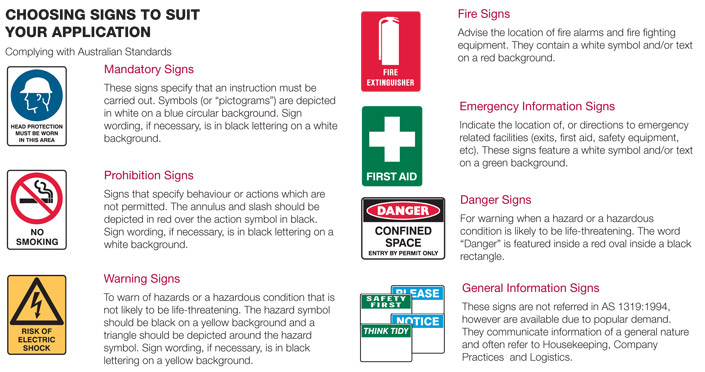Workplace First Aid
| Do you have a duty to provide first aid? Click Here What first aid is required for my workplace? Click Here Our Accidental Health and Safety First Aid Kits Click Here The importance of Safety Signs Click Here Personal Protective Equipment Click Here Visual Warning Click Here Lockout Tagout Click Here Spill Control Click Here Drug & Alcohol Testing Kits and Training Click Here Asset Management & Security Click Here Dangerous Goods Click Here Fire Safety Click Here Pipe Markers Click Here Scaffold Safety Click Here Forklift Safety Click Here Ladder Safety Click Here Height Safety Click Here Labels & Printing Solutions Click Here |
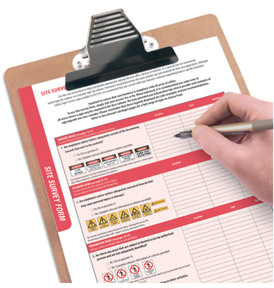 |
Click Here to Contact your Local Distributor for more information regarding Personal Protection Solutions |
|
 Do you have a duty to provide first aid? Do you have a duty to provide first aid?Under the Work Health and Safety Regulations (WHS) a person conducting a business or undertaking at a workplace (PCBU) must ensure the workplace is well equipped with first aid equipment and facility for administering first aid that is easily accessible to each worker. It is also essential that workplaces have adequate number of workers that are trained to administer first aid or workers having access to trained first aid officers. Back to Top |
|
| What first aid is required for my workplace? Deciding what first aid arrangement needs to be provided in the workplace is determined by legislative requirements and through a risk assessment taking into account the type of work performed, workplace size and location, as well as the number of people on site. 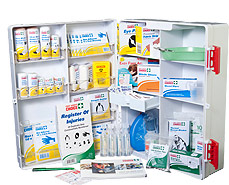 Identifying all reasonably foreseeable hazards and understanding the level of risk associated with those hazards will help you decide what first aid equipment, facilities and services you need. This process is known as risk management* and involves the following four steps: 1. Identifying hazards that could result in work-related injury or illness 2. Assessing the type, severity and likelihood of injuries and illness 3. Providing the appropriate first aid facilities and training, and 4. Reviewing your first aid requirements on a regular basis or as circumstances change. *Source: First Aid in the Workplace Model Code of Practice July 2012 For news updates please visit ahsworksafety.com.au. Back to Top |
|
Our Accidental Health and Safety First Aid Kits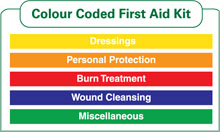 At Accidental, we make it easy for you to decide which First Aid Kit is required for your site. Our Workplace First Aid Kits modules are available for a wide variety of industries – making First Aid compliance easier for your workplace. Our Industrial First Aid Kits feature a Treatment Rating system that allows our users or First Aider's to quickly identify which products to use in an emergency. Accidental's First Aid kits are designed with our users on mind, making applying First Aid easy, simple and effective! |
|
Risk Guide Legend |
|
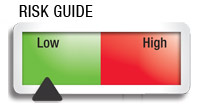 To assist you in selecting a first aid kit suitable for your workplace, we have designed a risk guide legend to help you identify the kit suited to your level of workplace risk. To assist you in selecting a first aid kit suitable for your workplace, we have designed a risk guide legend to help you identify the kit suited to your level of workplace risk.Low risk workplace means a workplace where workers are not exposed to hazards that could result in serious injury or illness such as offices, shops or libraries. Potential work-related injuries and illnesses requiring first aid would be minor in nature. High risk workplace means a workplace where workers are exposed to hazards that could result in serious injury or illness and would require first aid. For example, factories, construction sites, mobile plant, motor vehicle workshops and forestry operations. Back to Top |
|
The importance of Safety Signs |
|
| Safety Signs are crucial in any work environment. The primary importance of displaying Safety Signs is to prevent injury and ensure staff and visitors are well aware of the possible dangers and hazards ahead in certain situations and/or environments. Without signs, many employees would lack the necessary direction in times of crisis, and employers might find themselves in significant legal difficulties if any accidents were to arise as a result. By ensuring the workplace is sufficiently well signed, you can help protect your staff and visitors to the site, particularly members of the public, against the possible dangers that may be unnoticed - leading to less industrial accidents and reduced risk to employees and passerby's. We have a wide range of legends for you to choose from to ensure you can create a safe, well identified facility. Our range of Safety Signs are designed to meet Australian Standard 1319:1994 which outlines specific parameters for safety signs in an occupational environment. Understand Australian Standard AS 1319:1994 This standard sets out the requirements for the design and use of safety signs intended for use in the occupational environment. These signs are designed to regulate and control safety related behaviour, to warn of hazards and to provide emergency information including fire protection information. |
|
|
|
|
| Viewing Distance Guide | |
| Signs should be large enough to view without straining the eyes when communicating safety messages to employees and/or visitors. Therefore, choosing the size of a sign is more than fitting it to the space you have available. In order to comply with AS 1319:1994 you must consider the environment, lighting and viewing distance – these factors will determine the size of sign required to suit your application. The recommended minimum sizes as per AS 1319:1994 are as follow. For a pictogram and worded sign in a factory or work environment, where lighting is good and the sign will be mounted in a reasonably prominent position. • Pictogram size is to be at least 15mm per metre of viewing distance • Text size: - Upper case: 5mm per metre of viewing distance - Lower case: 4mm per metre of viewing distance |
|
|
|
|
| Personal Protective Equipment Personal Protective Equipment (PPE) is any clothing, equipment or substance designed to protect a person from risks of injury or illness. PPE provided by employers is required for the control of such risks identified by an employer's risk assessment. At Accidental, we have a broad range of quality PPE items to suit every individual to ensure your employee's are comfortable, visible and protected from risk. Click Here to view Personal Protective Equipment |
|
|
Visual Warning |
|
| Lockout Tagout A clearly defined Lockout procedure can help to meet your regulatory requirements for a safe workplace. We recommend that employees who perform service or maintenance work to equipment and who undertake the actual Lockout procedure must be able to: • Recognise hazardous energy sources. • Understand the types and extent of energy. • Know methods for isolating and controlling hazardous energy. • Know methods for the safe application, use and removal of Lockout devices. Using correct Lockout tools and devices is also critical to the success of your procedure implementation. When selecting your devices two questions should be asked – How many employees are involved in the procedure? What is the Energy source? Our selection of Lockout products help to facilitate an effective Energy Isolation Program that can prevent potentially fatal injuries in your workplace. The range of lockout products starts off by helping you with the basics - like planning, writing, training and implementing lockout procedures. Effective Lockout procedures can dramatically increase your company's productivity by making Lockout activities more efficient. Your procedures serve as a checklist that allows workers to quickly move through the steps without confusion or mistakes, reducing downtime and damage to machinery. |
|
| Spill Control The Environmental Protection Authority (EPA) enforces Risk Minimisation by Spill Control. The occupier must ensure that provision is made for spill containment that will, as far as practicable, contain within the occupier's facility or location of spill or leak of stated dangerous goods or combustible liquids. Heavy penalties are imposed upon failure to meet these requirements (source: QLD Dangerous Goods Safety Management Regulation 2001). Our range of Sorbents & Spill Containment products can assist you in meeting your obligations to provide a safe environment for your employees, protect your local environment and minimise your liability in the event of accidental spills. We also offer a range of environmentally friendly sorbents which is made from recycled cellulose and is up to 50% more absorbent. Sorbent products also ensure that the source of leaks, drips and spills are wiped clean allowing you to keep work areas "under control" and reduce liability. Click Here to view Spill Control Products |
|
| Drug & Alcohol Testing Kits and Training Statistics indicate that alcohol and drug misuse is a significant safety issue in Australian workplaces. Recent research demonstrates that one in sixteen employees go to work affected by drugs & alcohol. In fact it is estimated that between 3 and 11% of workplace injuries are alcohol related and approximately 2% of workplace fatalities are drug related. Under WHS legislation companies have a Duty of Care to ensure the health, welfare and safety of employees. To reduce the OHS risks associated with drugs & alcohol misuse in the workplace companies should implement a Drug & Alcohol Policy. To help control the use of alcohol & drugs on work premises ask our Service Consultants about our new Drug & Alcohol Testing Starter Kits. Only available to Accidental Health & Safety customers through trained & certified State Distributors. Click Here to view Drug & Alcohol Products Back to Top |
|
| Asset Management & Security Identify, protect and manage your company's valuable assets with our range of specialised DuraGuard® labels for durable, attractive and versatile Asset Identification. Tamper Evident Labels are also available for additional security. Identifying your property, from tools and warehouse equipment to office furniture and computers, will help you provide visible deterrents against theft and loss manage IT resources, equipment and upgrades and facilitate inventory control and meet your company's record keeping requirements. Click Here to Customise your Asset Identification Labels |
|
| Dangerous Goods All Hazardous Chemical/s used, handled or stored at the workplace must be correctly labelled according to the WHS Regulations. This is the responsibility of the person conducting a business or undertaking at a workplace. This requirement also extends to chemicals manufactured at the workplace or transferred/decanted from its original container at the workplace. The Globally Harmonised System of Classification and Labelling of Chemicals (GHS) is the new requirement for labelling of hazardous chemicals in the workplace. The key changes under GHS include new criteria for classification of chemicals, standardised label format and new GHS symbols. For more information visit the Safe Work Australia website www.safeworkaustralia.gov.au Current Safety Data Sheet for hazardous chemicals should also be available. These documents should be prepared in accordance with the necessary Regulations from the manufacturer, importer or supplier of the hazardous chemical. Australian Dangerous Goods Code (ADG7) The Australian Dangerous Goods Code (ADG7) outlines requirements for transporting dangerous goods by road or rail. As individual requirements vary, please refer directly to the ADG7 documentation available at www.ntc.gov.au Click Here to view Dangerous Goods Products Back to Top |
|
| Fire Safety Emergency plans and safety equipment are necessary in the control of risk. In relation to hazardous chemicals workplaces needs to be equipped with fire protection and fire fighting equipment that is compatible with chemicals that are being stored, generated and handled at the workplace. At Accidental, we have a complete range of Fire Safety Products. Source – Compendium of Workers Compensation Statistics Australia 2006-07. Click Here to view Fire Safety Products |
|
| Pipe Markers Why Mark Pipes? Pipe markers aid in the quick identification of a pipes' contents – especially in an emergency situation. A successful pipe identification program helps employees, contractors and emergency responders to distinguish between pipes where there are several side by side. Pipe markers also save valuable time when tracing lines is necessary during maintenance. Where Should Pipe Markers be Located? AS 1345 specifies that markers be placed adjacent to all junctions, valves, service appliances, bulkhead and wall penetrations. Markers shall be spaced no more than 8m apart except for long, uninterrupted straight runs of external services where spacing shall not exceed 50m. Australian Standard AS1345-1995 specifies means of identifying the contents of pipes, conduits, ducts and sheathing used to contain fluids or for the distribution of electrical or communications services in landinstallations and on board ships, by the use of colours, words and symbols. The Standard also addresses several elements of pipe marker design including Marker Layout - a marker is comprised of a printed word or words on a coloured background with a contrasting border and chevron to show direction of flow. At Accidental, we provide a large range of Pipe Markers, as well as Custom Pipe Markers. Click Here to view Pipe Markers |
|
| Scaffold Safety The Work Health and Safety Regulation states that a person responsible for a scaffold at a workplace must ensure that the scaffold is not used unless written confirmation is received from a competent person. This regulation applies to suspended, cantilevered, spur or hung scaffold and any other scaffold from which a person or thing could fall more than 4 metres. Scafftag offers a unique set of advantages in managing safety risk assessments within your workplace. The comprehensive Scafftag range can be used for most applications. Insert designs are available in a range of standard wordings which clearly mark information or a danger, but can be easily customised to suit your needs. Weatherproof, UV protected and durable, this cost effective system can withstand the toughest industrial environments. Click Here to view Scaffold Safety Products |
|
| Forklift Safety Forklift related accidents can be fatal and usually occur because workers are unseen by the operator. So ALERT your employees to the hazards with safety signs and floor markers and don't let your workplace add to the statistics. Click Here to view Forklift Safety Products |
|
| Ladder Safety Regulations require ladders to be checked for damage, faults and wear before use by an authorised user. Laddertag is a complete ladder safety management system. This easy to use system is essential for companies working to ISO9000 standards. The holder and inserts provide a 3 stage information system – Do not use, Fit to use and Warning is highly visible. The tags are weatherproof, UV protected, durable and able to withstand the toughest industrial environments. Click Here to view Ladder Safety Products |
|
| Height Safety Approximately 900 reported workplace injuries in South Australia were sustained while working at heights, in the year 2000. Source safework.sa.gov.au It is recommended that where there is a risk that a worker could 2 metres or more, it is required to ensure that: Designed and manufactured in Australia, our harnesses and lanyards are manufactured according to AS/NZS Click Here to view Height Safety Products |
|
| Labels & Printing Solutions With Brady DIY Labelling solutions, you have control. Produce professional quality, customised labels on demand. No external supplier minimum order quantities or lead times – simply print whatever you like – instantly, whenever you need to. Investing in a DIY printing solution can help your business to save money, improve productivity and stay compliant with safety standards. Brady invests millions of dollars into researching and developing materials for labels that stand the test of time under the toughest conditions. Whether it's adhering to a frozen test tube or resisting heat and chemicals in an aerospace environment, Brady has a label to meet your demands. Click Here to view Printing Solutions Products |
|
Categories
- First Aid Kits
-
First Aid Supplies
- Antiseptics
- Bandages
- Bites & Stings
- Burn Creams & Gels
- Dressings
- Eye Care
- Finger Cots
- First Aid Instructions & Reporting
- First Aid instruments
- First Aid Kit Labels
- Infection Control
- Insect Repellent
- Personal Care
- Pharmacy
- Plastic Bags & Modules
- Sports
- Surgical Face Masks
- Tapes
- Thermal Rescue Blanket
- Wound Closure Strips
- First Aid Room
- First Aid Equipment
- First Aid Kit Cases
- Personal Protective Equipment
- Rescue
-
Signs
- Visual Warning
- Braille Signs
- Custom Signs
- Information Signs
-
Safety Signs
- Building & Construction Signs
- Danger Signs
- Door Signs
- Engraved Signs
- Exit Signs
- Fire Safety Signs
- First Aid & Emergency Signs
- Forklift Safety Signs
- Housekeeping Signs
- Kitchen & Food Safety Signs
- Lockout Signs
- Machinery & Operational Signs
- Mandatory Signs
- Mining Signs
- Multilingual Signs
- Multimessage Signs
- No Smoking Signs
- Notice Signs
- Numbers & Letters
- Overhead Signs
- Prohibition Signs
- Property Signs
- Quality Signs
- Recycling Signs
- Safety Information Signs
- Scaffolding Signs
- Sign Posts & Accessories
- UltraTuff Signs
- Warning Signs
- Traffic & Parking Signs
- Warehouse Signs
- Social Distancing & Visitor Control
- Spill Control
-
Workplace Safety
- Asset Management & Security
- Cable & Cord Protectors
- Dangerous Goods
- Drug & Alcohol Testing
- Emblems & Badges
- Fire Safety
- Height Safety
- Labels & Tags
- Labels
- Lockout Tagout
- Manual Handling
- No Smoking
- Safety Posters
- Washroom & Cleaning Products
- Workplace Mats
- PPE Storage & Dispensers
- Skin Care
- Disposable Clothing
- Traffic & Parking
- Hand Sanitising Stands
- GHS
 1300 362 327
1300 362 327 

